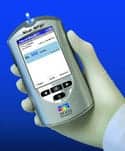09/07/06
Nanogen Inc has been granted US Patent No. 7,060,224 from the US Patent and Trademark Office for an application of its core technology in nanofabrication and nanomanufacturing. Potential uses of the technology range from further miniaturization of the company’s microarray testing platforms to potential applications in integrated electronics and photonics, photovoltaics, fuel cells, and batteries.
“The patent demonstrates the underlying strength and robustness of our basic electronic microarray technology and our commitment to continuing fundamental R&D to protect our strong IP position in the nascent and growing field of nanotechnology,” says Howard C. Birndorf, Nanogen chairman and CEO.
Covered by the patent are nanofabrication applications of Nanogen’s proprietary “electronic addressing” microarray employed in the company’s NanoChip® 400 system for molecular diagnostic applications. The patent describes a technology by which both nanoscale and microscale components can be manipulated and selectively positioned to achieve a desired structure in a rapid and cost-efficient manner. The non-mechanical “pick and place” technology allows the placement of components at targeted positions on a microarray template, which can then be linked together in a specific and directed manner.
“It’s currently relatively easy to make various types of nanoparticles, but it’s hard to put different kinds of nanoparticles and other nanocomponents together,” says Michael J. Heller, a co-founder of Nanogen and professor of electrical and computer engineering and bioengineering at the University of California, San Diego. “And it’s even harder to combine nanoparticles with components of other size scales, like you would need to do in order to build an integrated sensor device, for example, that could circulate within the body, detecting disease and releasing medication as appropriate. The non-mechanical ‘pick and place’ allows for this type of integrated assembly.”
Nanogen has an extensive portfolio of intellectual property relating to integrated assembly of molecular structures through the use of electric field microfabrication technology. The patent builds on that portfolio and relates specifically to a process in which nano, micro, and macro components are attached to one another through solder reflow following electroosmostic positioning.
The technology is particularly applicable to manufacturing of photovoltaic devices, fuel cells and batteries, as well as various hybrid-integrated components including flat panel displays, wireless/RF integrated devices, lab on a chip devices, microcantilever sensor devices, atomic force microscope devices, integrated MEMS/optical/microelectronic devices, integrated microscopic analytical and diagnostic devices, and compact, handheld medical diagnostic devices and systems. The technology can also be used to manufacture the company’s core microarray testing platforms.
“Fabricating complex integrated devices right now usually requires that each component be built separately and then assembled. Interfaces that integrate function across the various components can be difficult to achieve,” says Heller. “Using the non-mechanical ‘pick and place’ technology described in the ‘224 patent facilitates integrated assembly of these complex structures.”


